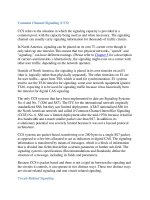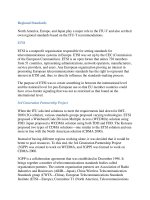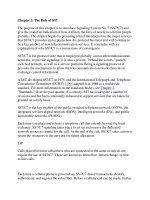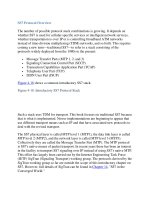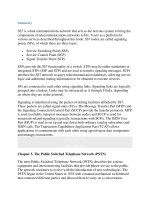Signaling System No.7 Protocol Architecture And Sevices part 3 pps
Bạn đang xem bản rút gọn của tài liệu. Xem và tải ngay bản đầy đủ của tài liệu tại đây (54.1 KB, 7 trang )
Channel Associated Signaling
The key feature that distinguishes Channel Associated Signaling (CAS) from CCS
is the deterministic relationship between the call-control signals and the bearers
(voice circuits) they control in CAS systems. In other words, a dedicated fixed
signaling capacity is set aside for each and every trunk in a fixed, pre-determined
way.
Channel Associated Signaling (CAS) is often still used for international signaling;
national systems in richer nations almost exclusively use Common Channel
Signaling (CCS). CCS is replacing CAS on international interfaces.
CAS can be implemented using the following related systems:
• Bell Systems MF, R2, R1, and C5.
• Single-frequency (SF) in-band and out-of-band signaling
• Robbed bit signaling
The following sections discuss these methods in context with the type of signal,
either address or supervisory.
A
ddress Si
g
nals
Multifrequency systems, such as the Bell System MF, R2, R1, and C5, are all types
of address signals used by CAS.
Multifrequency
The CAS system can be used on either analog Frequency Division Multiplexed
(FDM) or digital Time Division Multiplexed (TDM) trunks. MF is used to signal
the address digits between the switches.
Multifrequency (MF) signaling can still be found in traces within the United States,
and it is still often found on international interfaces. On international interfaces
outside of North America, MF is still used via the CCITT System 5 (C5)
implementation. C5 is quite similar to Bell MF and was developed jointly by Bell
Laboratories and the British Post Office [102
]. R2 is the MF system that was
deployed outside North America and is still used in less developed nations. R2 was
developed by CEPT (which later became ETSI; see Chapter 2
) and was previously
known as Multifrequency Compelled (MFC) signaling. The CCITT later defined
an international version; see Chapter 2 for additional information regarding the
international version [102
].
MF simultaneously sends two frequencies, from a choice of six, to convey an
address signal. The switch indicates to the switch on the other end of a trunk that it
wishes to transmit address digits by sending the KP (start pulsing) signal, and
indicates the end of address digits by sending the ST (end pulsing) signal. The
timing of MF signals is a nominal 60 ms, except for KP, which has a nominal
duration of 100 ms. A nominal 60 ms should be between digits.
Table 1-3
shows the tone combinations for Bell System MF, R1, and C5. R2 tone
combinations are not shown.
Table 1-3. Tones Used to Create MF Signals
Digit Frequencies
700 900 1100 1300 1500 1700
1 + +
2 + +
3 + +
4 + +
5 + +
6 + +
7 + +
8 + +
9 + +
0 + +
KP + +
ST + +
11
[*]
+ +
12
[*]
+ +
KP2
[*]
+ +
[*]
= Used only on CCITT System 5 (C5) for international calling.
As stated, many international trunks still use C5. Signal KP2 indicates that the
number is an international number; by inference, KP indicates that the number is a
national number. International operators also use codes 11 and 12. More details on
C5 are available in ITU-T Q.152. Supervision signals for MF systems are
p
erformed on FDM trunks by the use of Single Frequency (SF), which we describe
in the following section.
For circuit supervision,
b
oth Bell System MF and R1 use Single Frequency (SF) on
FDM trunks and employ robbed bit signaling on TDM controlled trunks. C5 uses a
different set of MF tones for supervisory signaling.
S
upervisor
y
Si
g
nals
Single frequency systems, robbed bit signaling, and digital signaling are all types
of supervisory signals used by CAS.
Single Frequency(SF)
Single Frequency (SF) was used for supervisory signaling in analog CAS-based
systems. North America used a frequency of 2600 Hz (1600 Hz was previously
used), and Great Britain used 2280 Hz (as defined in British Telecom's SSAC15
signaling specification). When in an on-hook state, the tone is present; when in an
off-hook state, the tone is dropped.
N
OTE
Supervisory signals operate similarly to those used in access signaling; however,
they signal the trunk state between two switches rather than the intention to place
or terminate a call. Supervisory signals are also known as line signals.
Table 1-4
details the tone transitions Bell System MF and R1 use to indicate the
supervision signals. C5 uses a combination of both one and two in-band signaling
tones, which are not presented here.
Table 1-4. Bell System MF and R1 Supervision Signaling
Direction Signal Type Transition
Forward Seizure On-hook to off-hook
Forward Clear-forward Off-hook to on-hook
Backward Answer On-hook to off-hook
Backward Clear-back Off-hook to on-hook
Backward Proceed-to-send (wink) Off-hook pulse, 120–290 ms
As with the MF address signaling, SF is sent switch to switch. A trunk is initially
on-hook at both ends. One of the switches sends a forward off-hook (seizure) to
reserve a trunk. The receiving switch indicates that it is ready to receive address
digits, (after connecting a digit received by the line by sending a wink signal.
When the originating switch receives the wink signal, it transmits the digits of the
called party number. When a call is answered, the called parties switch sends an
off-hook signal (answer). During the conversation phase, both ends at each trunk
are off-hook. If the calling a party clears the call, it sends a clear-forward signal;
likewise, when the called party hangs up, it sends a clear-backward signal.
SF uses an in-band tone. In-
b
and systems send the signaling information within the
user's voice frequency range (300 Hz to 3400 Hz). A major problem with in-band
supervisory signaling, however, is its susceptibility to fraud. The hacker quarterly
magazine "2600" was named for the infamous 2600 Hz tone, which could be used
by the public to trick the phone system into giving out free calls. The subscriber
could send supervisory tone sequences down his telephone's mouthpiece using a
handheld tone generator. This enabled the subscriber to instruct switches and, in
doing so, illegally place free telephone calls.
The other major problem with in-band signaling is its contention with user traffic
(speech). Because they share the same frequency
b
andwidth, only signaling or user
traffic can be present at any one time. Therefore, in-band signaling is restricted to
setting up and clearing calls down only because signaling is not possible once a
call is in progress.
Subscriber Line Signaling
A regular subscriber line (that is analog) still uses in-band access
signaling. For example, DTMF is used to signal the dialed digits and the
frequencies used are within the voice band (see Table 1-1
). You can
prove that DTMF uses in-band signaling by using a device, such as a
computer, to generate the tones for each digit (with correct pauses).
Simply play the tones from the computer speaker down the mouthpiece
of a touch-tone telephone. This allows you to dial a number without
using the telephone keypad. Because the signaling is sent down the
mouthpiece, you can be certain that it traveled within the user's voice
frequency range.
FDM analog systems nearly always reserve up to 4000 Hz for each circuit, but
only use 300–3400 Hz for speech; therefore, signaling is sent above the 3400 Hz
(and below 4000 Hz). This is known as out-of-band signaling and is used in R2 for
supervisory signaling. Unlike with in-band signaling, no contention exists between
user traffic and signaling. North America uses a frequency of 3700 Hz, and CCITT
(international) uses 3825 Hz. Table 1-5
details the tone transitions that indicate the
supervision signals used in R2 and R1.
Table 1-5. R2 Supervision Signaling
Direction Signal Type Transition
Forward Seizure Tone-on to tone-off
Forward Clear-forward Tone-off to tone-on
Backward Answer Tone-on to tone-off
Backward Clear-back Tone-off to tone-on
Backward Release-guard 450 ms tone-off pulse
Backward Blocking Tone-on to tone-off
R2 does not use a proceed-to-send signal; instead, it includes a blocking signal to
stop the circuit that is being seized while maintenance work is performed on the
trunk. The release guard signal indicates that the trunk has been released after a
clear-forward signaling, thereby indicating that the trunk can be used for another
call.
Digital
Supervisory signaling can be performed for R2 on digital TDM trunks. On an E1
facility, timeslot 16 is set aside for supervisory signaling bits (TS16). These bits
are arranged in a multiframe structure so that specific bits in the multiframe's
specific frames represent the signaling information for a given TDM audio
channel. See Chapter 5
, "The Public Switched Telephone Network (PSTN)," for
explanation of facilities and timeslots.
L
imitations o
f
CAS
We discuss the general disadvantages of CAS for the purpose of reinforcing the
concepts and principles we have introduced thus far. CAS has a number of
limitations, including:
• Susceptibility to fraud
• Limited signaling states
• Poor resource usage/allocation
The following sections discuss these limitations in more detail.
Susceptibility to Fraud
CAS employing in-band supervisory signaling is extremely susceptible to fraud
because the subscriber can generate these signals by simply using a tone generator
down a handset mouthpiece. This type of device is known as a blue box; from the
beginning of the 1970s, it could be purchased as a small, handheld keypad. Blue
box software was available for the personal computer by the beginning of the
1980s.
Limited Signaling Information
CAS is limited by the amount of information that can be signaled using the voice
channel. Because only a small portion of the voice band is used for signaling, often
CAS cannot meet the requirements of today's modern networks, which require
much higher bandwidth signaling.
Inefficient Use of Resources
CAS systems are inefficient because they require either continuous signaling or, in
the case of digital CAS, at regular intervals even without new signals.
In addition, there is contention between voice and signaling with in-band CAS. As
a result, signaling is limited to call set-up and release phases only. This means that
signaling cannot take place during the call connection phase, severely imposing
technological limits on the system's complexity and usefulness.


